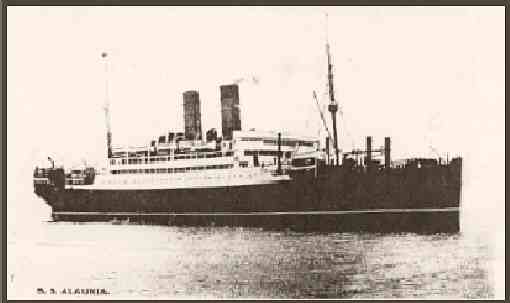

6 and 7th Battalions RDF sailing from Avonmouth on the Alaunia on the March 15, 1915, passing through Gibraltar, Malta and the Greek Islands, and then sailing to Cape Helles, on the tip of the Gallipoli Peninsula, on the April 25. Their final destination was V Beach, intended to be the largest and most important of the Helles landings. Despite the carnage, V Beach was nonetheless eventually taken by the Allies, and, by the April 26, those troops left alive were all ashore.
Built: 1913 by Scotts SB Co, Greenock.
Tonnage: 13,405 grt, 8,464 nt.
Engines: Twin screw, quadruple expansion by builder.
Passengers: 520 2nd Class, 1,540 3rd Class.
Alaunia was built with the Canadian trade in mind and sailed on her maiden voyage on the 3rd of December 1913 from Liverpool to Portland. Taken up for trooping duties at the outbreak of war and commencing the 27th of August transported Canadian troops for the following six months. Re-entered commercial trade in 1916 and sailed from London on the 11th of May bound for New York via Falmouth and Plymouth. On the 19th of October she struck a mine when two miles from the Royal Sovereign lightship and sank, two lives were lost.
The Alaunia I itself was built in 1913 in the run-up to the First World War. The Cunard Line had inaugurated its own Canadian service in 1911. The company was aware that it needed its own purpose-built ships for that profitable route. Thus, three vessels were ordered from Scotts Shipbuilding & Engineering Company of Greenock, Glasgow, the Andania, the Alaunia land the Aurania.
The Alaunia was the second of the three ships to be launched, on 9 June 1913. She weighed in at 13,405 tons gross and was fitted out with twin-screw quadruple-expansion engines manufactured by the shipbuilders, which developed 8,500hp, enough to push her and her sister ships to a top speed of 14.5 knots. The Alaunia was constructed of steel with three decks and bridge superstructure, which gave her a total height of 243 feet. She was 540 feet long with a beam of 64 feet. On board was accommodation for 520 second class and 1,620 third-class passengers. The usual third-class dormitories were replaced in this vessel by four- and six-berth cabins. She carried a crew of 289.
The Alaunia, Andania and Aurania were more or less identical vessels. Each was fitted with two masts and each had two towering funnels amidships in the Cunard Line's classic red with black bands at the top.
The Alaunia made its maiden voyage on 27 November 1913 from Liverpool to Boston via Queenstown and Portland, arriving in Boston on 6 December 1913. She went on to continue regular Atlantic crossings throughout the first half of 1914 taking emigrants to new lives in America. However, the Great War which was now engulfing Europe caught up with the Alaunia in August 1914, when she was requisitioned as a troopship. The Andania was requisitioned just two months later in October, also as a troopship.
Its master was Captain Rostron (Royal Naval Reserve). He had been the Captain of the Carpathia when it picked up survivors of the Titanic disaster in 1912
In 1916, the Alaunia returned to the cold North Atlantic to her first wartime role of carrying troops to the European theatre from Canada and America. She was joined on the London to New York run by one of her two original sister ships, the Andania. It was in this role that the Alaunia left London on 19 September 1916 on a return voyage to New York. Unbeknown to her, the hand of fate was now turning against her, for the return leg of this voyage was to be her last.
Royal Dublin Fusiliers 6th battalion
Royal Dublin Fusiliers 7th battalion